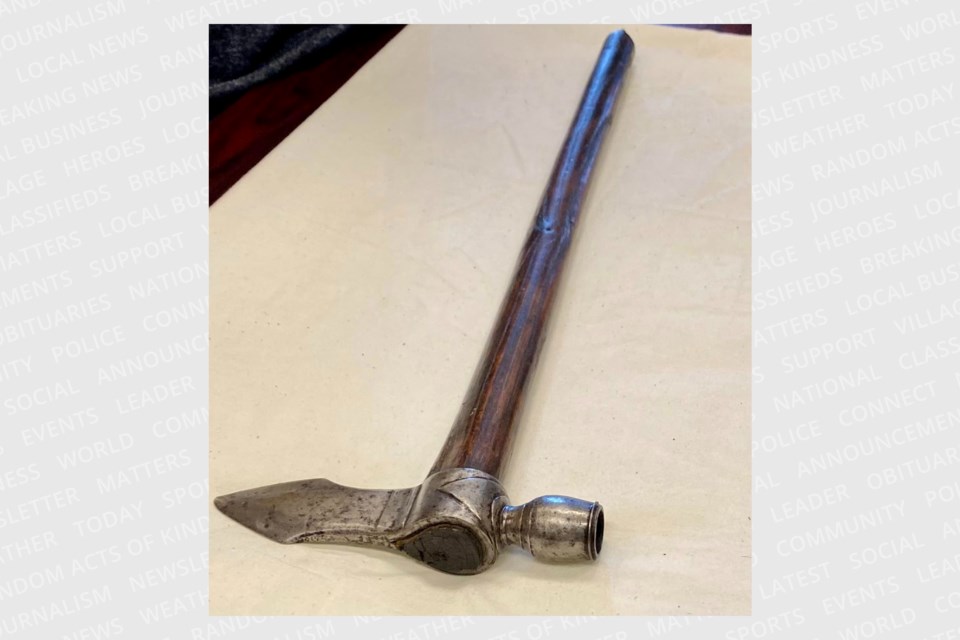EDITOR'S NOTE: This article originally appeared on SooToday on May 19, 2023. It is being republished here for readers who may have missed it.
Members of Garden River First Nation entered Queen’s Park Thursday as the sound of drumming filled the air — a symbolic gesture meant to signify the quest to reclaim land they say was stolen and repatriate sacred items once belonging to one of the community’s most formidable and historic leaders.
The First Nation’s visit to the provincial legislature followed the filing of a lawsuit against the federal and provincial governments, alleging the community was coerced into giving up 30,000 hectares of its land base, which was then sold off by the Crown to farmers and developers, according to the 14-page statement of claim filed in Ontario Superior Court.
After conducting a ceremony and taking questions from media, Ogimaa Andy Rickard, Anishinabek Nation Regional Deputy Grand Council Chief Travis Boissoneau, and Kiiwetinoong MPP Sol Mamakwa were backed by ceremonial helpers, traditional knowledge keepers and a drum group while cultural advisor Darrell Boissoneau carried the community’s eagle staff into the legislative chamber.
“It was more or less like a grand entry,” said Garden River First Nation Ogimaa Andy Rickard, speaking with SooToday from Toronto Friday. “We lined up in the halls, and we started off the process and went through with the drums vibrating the walls of the chambers of the legislature.”
Not only was Garden River First Nation cleared to bring its eagle staff into the legislative chamber, its presence was also acknowledged by members of provincial parliament and the speaker of the legislative assembly as community members looked on from the upper level.
Mamakwa, who helped facilitate the First Nation’s appearance in Queen’s Park Thursday, posed questions to the Ford government regarding outstanding land claim issues on the community’s behalf.
“It was really meaningful stuff, for us to have an MPP from one of the parties to ask the governing party some of those questions we were hoping to get some sort of answer from,” Rickard said.
Garden River leadership then surprised their Elders with a viewing of a 200-year-old pipe that belonged to the man who helped start Garden River in the 1800s, Chief Shingwaukonse. The Royal Ontario Museum (ROM), which has had the pipe since its inception in 1914, brought the pipe — along with a number of other sacred items belonging to the historic leader — to the legislature after meeting with Garden River leadership at the museum earlier this week.
“Just to be in the presence of a pipe that was probably used in times of war or prayer or a ceremony, it was pretty significant,” said Rickard, adding that Elders in the jam-packed were filled with emotion while viewing the pipe of Chief Shingwaukonse. “It was meant to be in terms of his presence that day, that marked our intent to right the wrongs of the past.”
Rickard says the formal process to repatriate sacred items once possessed by Chief Shingwaukonse back to Garden River has begun, and so far, talks with ROM officials have been positive and “respectful.”
“The intent is there from the ROM to return those sacred items to our community,” he said. “But at the same time, we recognize in Garden River that we need to make sure that we have the proper mechanisms in place, that we have the proper care, in order for those items to make their way back to our community.”
The First Nation is also seeking compensation, Rickard says, for the large parcel of land leadership says was stolen by the government of the day “through methods and tactics that were not necessarily respectful.”
The Crown continued to pressure Garden River to give up all of its land, according to the claim, and Garden River eventually gave up some of it, while in the throes of economic hardship, by 1859.
But the Crown pressured a vulnerable population to sign that treaty, the claim said, which meant losing 70 per cent of its territory.
The First Nation has a land base of little more than 20,000 hectares today.
Rickard realizes that much of the land in question is currently held by homeowners in neighbouring townships — namely the Township Of Macdonald, Meredith And Aberdeen Additional.
“Our fight is not with them,” said Rickard. “Obviously, we always approach respectfully and with open dialogue to educate, but also just to let all those people know who might not be aware of how those lands became some of the things that they enjoy today.”
Rickard says his First Nation wants to reclaim any unoccupied lands within the land base surrendered to the Crown through the Pennefather treaties. Compensation for the remaining lands that are currently inhabited, he adds, would have to be discussed.
“We don’t want to uproot them. We don’t want to be landlords over their lands or anything like that,” he said. “I’m sure at some point in time we’ll have to have a conversation with the province and the federal government about how we navigate those difficult conversations.”
- with files from The Canadian Press
